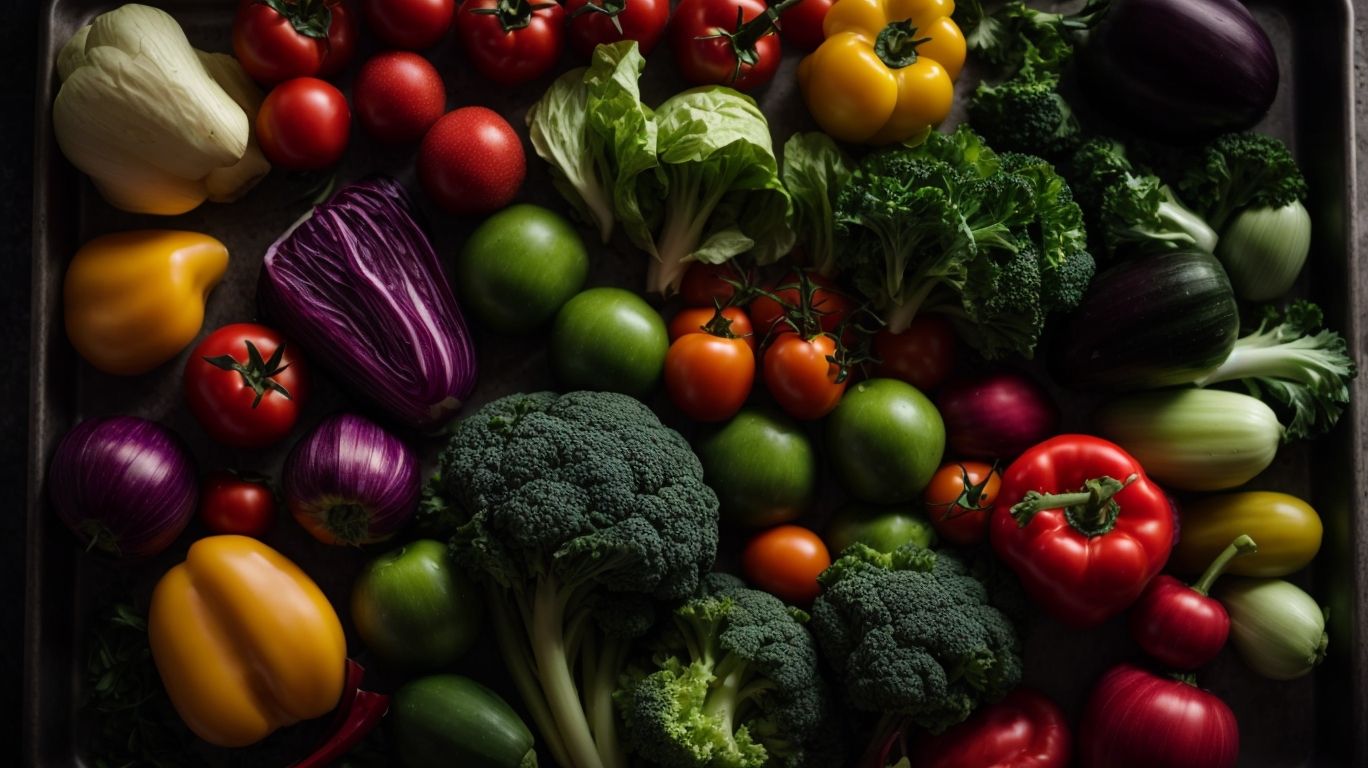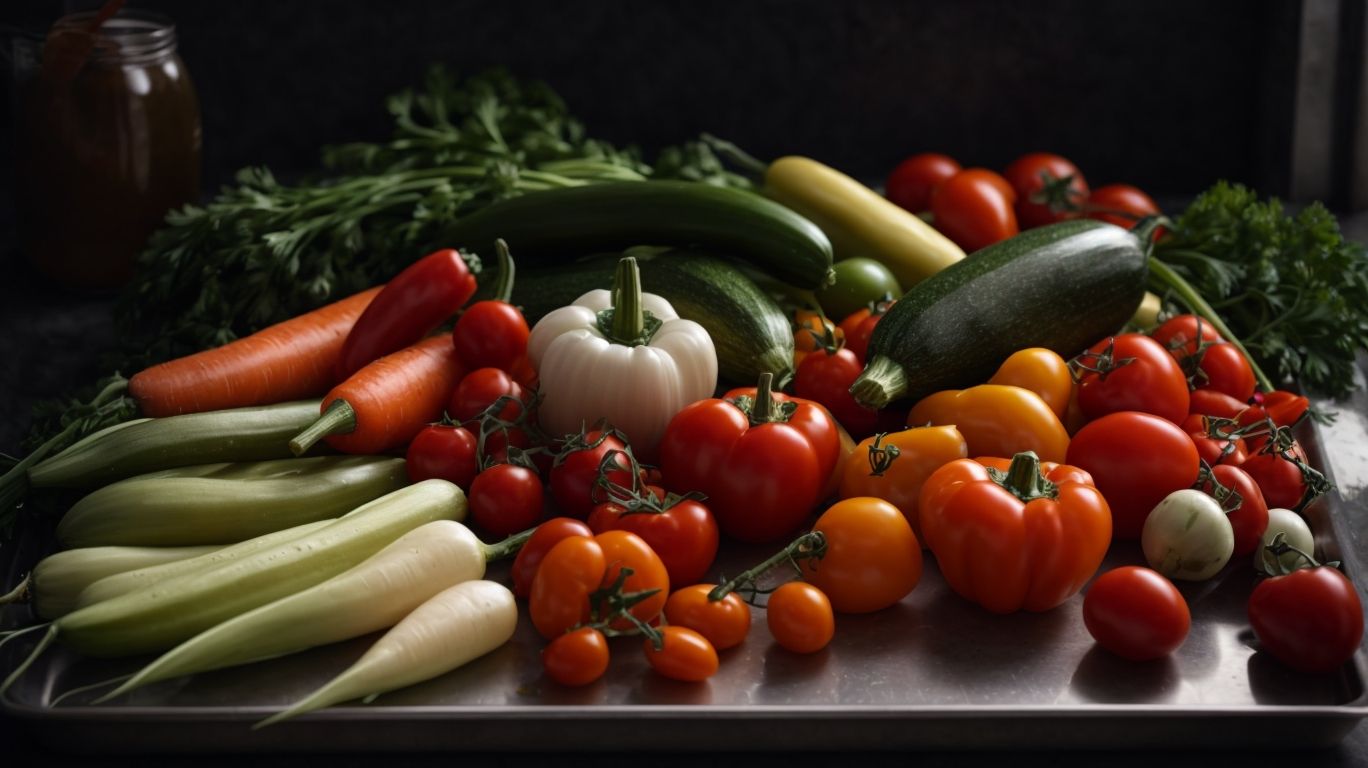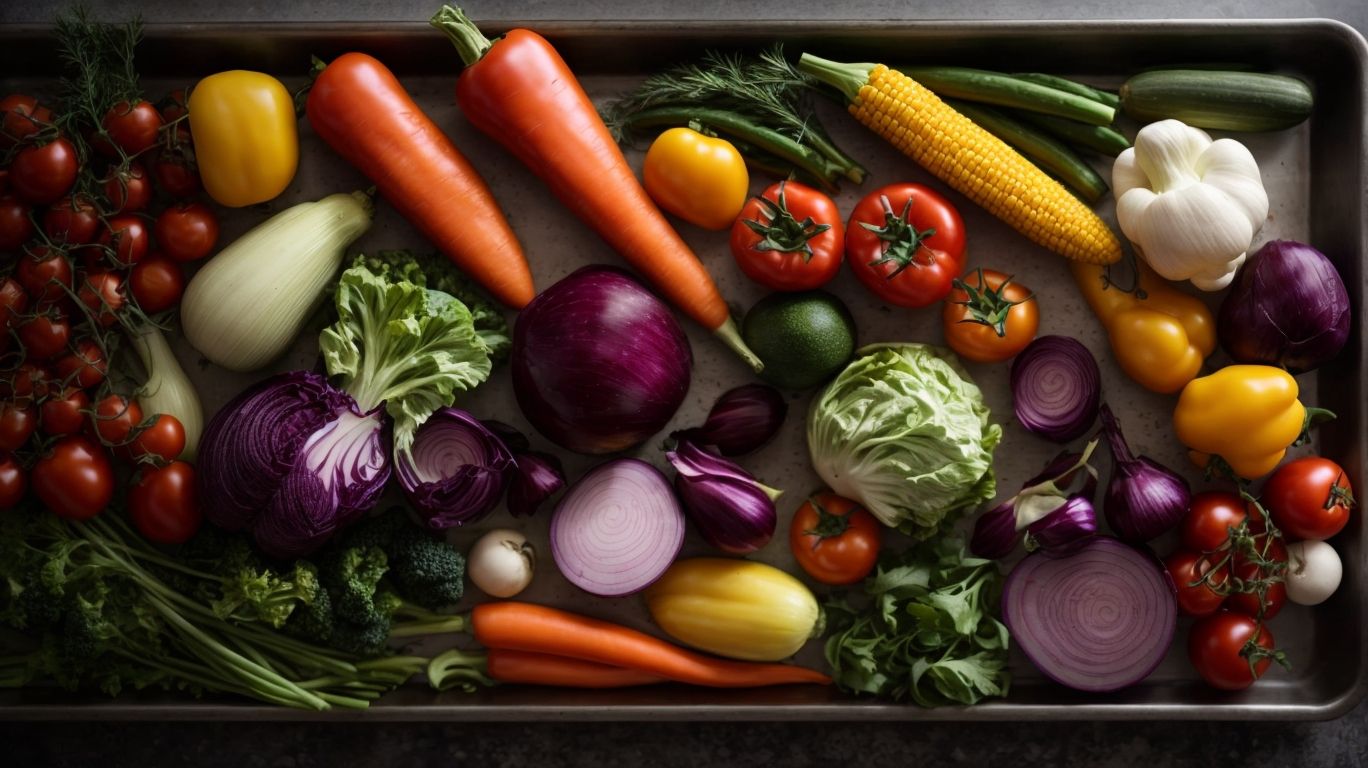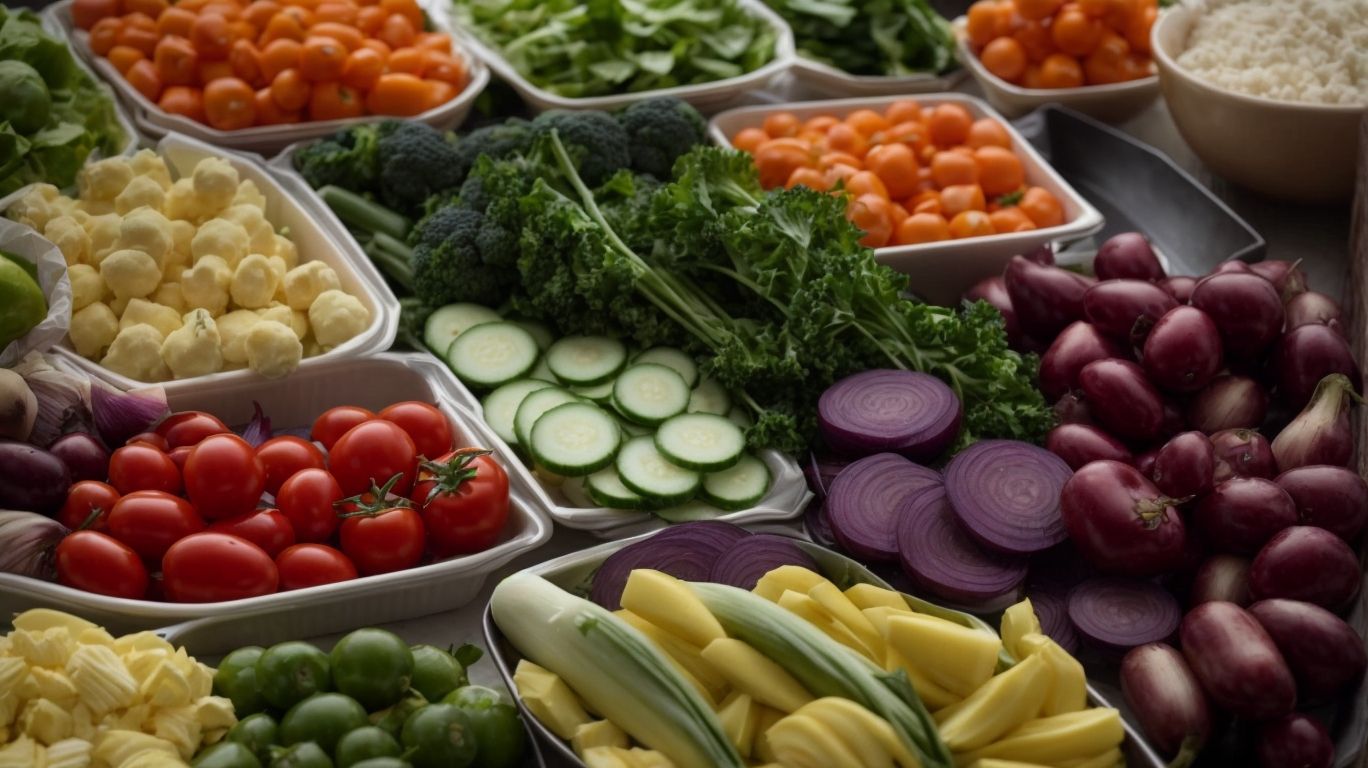How to Bake Vegetables in Oven?
Are you looking to add more vegetables to your diet in a delicious way?
Baking vegetables in the oven is a fantastic method that retains nutrients, enhances flavor, and offers versatility in cooking.
In this article, we will explore the benefits of baking vegetables, the best vegetables to bake, how to prepare them, the essential equipment needed, and the step-by-step process to achieve perfectly baked vegetables.
Stay tuned for expert tips and tricks to elevate your vegetable dishes to the next level!
Key Takeaways:
Why Bake Vegetables in Oven?
Baking vegetables in the oven is a fantastic cooking method that retains the nutrients and enhances the flavor of the vegetables, offering a versatile and convenient way to prepare a variety of dishes.
When you bake vegetables, the heat helps break down the cell walls of the vegetables, making the nutrients easier for your body to absorb. This method preserves the vitamins, minerals, and antioxidants that are essential for your health. Roasting brings out the natural sweetness of the vegetables, creating a caramelized and rich flavor profile that is irresistible to many. Whether you roast a medley of colorful veggies like bell peppers, zucchini, and cherry tomatoes, or opt for root vegetables like carrots and sweet potatoes, the possibilities are endless.
Retains Nutrients
Baking vegetables retains essential nutrients that are often lost through other cooking methods, ensuring that you get the maximum nutritional benefits from your dishes.
When you bake vegetables, the intense heat helps to lock in crucial vitamins like Vitamin C and minerals such as potassium and magnesium, which might otherwise leach out during boiling or frying. The process of roasting brings out the natural sugars in vegetables, enhancing their flavors without the need for excess fats or oils. This method of cooking also helps in breaking down tough fibers, making vegetables easier to digest and absorb their nutrients.
In comparison to boiling or steaming, where nutrients may seep into the cooking water, baking vegetables in the oven ensures that all the essential nutrients stay concentrated within the veggies, ready for you to enjoy. The caramelization that occurs during baking not only adds depth of flavor but also enhances the overall appeal of the dish, making it a versatile and delicious way to incorporate more vegetables into your diet.
Enhances Flavor
Baking vegetables in the oven enhances their natural flavors, creating delicious dishes that are rich in taste and aroma, making them a delightful addition to any meal.
When vegetables are roasted in the oven, the dry heat caramelizes their sugars, intensifying their flavors and bringing out their sweetness. This process also creates a delightful contrast between the crisp exterior and the tender interior of the vegetables, adding a textural element to the dish.
Oven roasting allows for the development of complex flavor profiles as the vegetables are infused with herbs, spices, and seasonings, enhancing their overall taste. The low and slow cooking method in the oven ensures that the vegetables cook evenly, resulting in a delectable melding of flavors with each bite.
Versatile Cooking Method
Using the oven for baking vegetables offers a versatile cooking method that allows individuals to prepare a wide range of vegetable dishes, from simple sides to elaborate main courses.
This method of cooking veggies not only enhances their natural flavors through caramelization but also retains more nutrients compared to other cooking techniques like boiling.
-
Oven roasting is particularly popular for root vegetables like sweet potatoes, carrots, and beets, highlighting their inherent sweetness and earthy tones. The high heat from the oven crisps up the exteriors while keeping the interiors tender, creating a delightful textural contrast.
-
Baking vegetables opens up a world of seasoning possibilities. Whether you prefer a classic mix of garlic, olive oil, and herbs or a spicy kick with paprika and cumin, the oven provides the perfect environment for flavors to meld and intensify.
What Vegetables Can Be Baked in Oven?

Credits: Poormet.Com – Austin Allen
A variety of vegetables can be baked in the oven, including popular choices like roasted broccoli, carrots, and bell peppers, offering a delicious and nutritious option for vegetable lovers.
When preparing these vegetables for oven baking, it’s essential to cut them into uniform sizes to ensure even cooking.
- Broccoli florets can be tossed with olive oil, garlic, and a sprinkle of Parmesan cheese for a savory twist.
- Carrots, when roasted, caramelize beautifully with a drizzle of honey and a sprinkle of thyme.
- Bell peppers, with their vibrant colors, add a sweet and slightly charred flavor when roasted with a bit of balsamic vinegar.
Roasted veggies make a versatile side dish or a lovely addition to salads, pastas, or grain bowls. They not only provide a burst of flavor but also retain their nutritional value through the baking process. This cooking method enhances the natural sweetness of the vegetables, making them appealing even to those who are not usually fond of veggies.
How to Prepare Vegetables for Baking?

Credits: Poormet.Com – Bruce Sanchez
Preparing vegetables for baking involves washing and drying them thoroughly, cutting them into uniform pieces, and seasoning them with your preferred herbs and spices for added flavor.
When washing the vegetables, it is important to remove any dirt or debris. Some vegetables may need peeling before cutting, while others can be left unpeeled for added texture and nutrients. It’s essential to cut the vegetables into similar sizes to ensure even cooking.
After cutting, you can toss the vegetables in a bowl with olive oil, salt, pepper, and any seasonings of your choice. Popular options include garlic powder, paprika, and rosemary. Make sure to coat the vegetables evenly before spreading them out on a baking sheet.
Wash and Dry Vegetables
Before baking, ensure to wash and dry the vegetables properly to remove any dirt or residue, maintaining their freshness and cleanliness for the cooking process.
Washing vegetables is a crucial step as it helps eliminate harmful bacteria that might be present on the surface. By rinsing them under cool running water, you can ensure that any contaminants are washed away. Proper hygiene practices are key in preventing foodborne illnesses. Drying the vegetables thoroughly after washing is equally important to prevent any moisture from affecting the texture or cooking process.
When washing leafy greens, separate the leaves and soak them in a bowl of water to loosen any dust or debris. Use a vegetable brush for items like potatoes or carrots to scrub off dirt effectively. This process not only cleans the vegetables but also enhances their flavor and appearance.
Cut Vegetables into Uniform Pieces
Cutting vegetables into uniform pieces ensures even cooking and consistent doneness, allowing you to enjoy perfectly roasted vegetables with each bite.
When your vegetables are cut uniformly, they will all be done at the same time, preventing some from being overcooked while others are underdone. This attention to detail in cutting ensures that different vegetables cook evenly, maintaining their individual textures and flavors.
Moreover, uniform cutting leads to a visually appealing dish. When vegetables are all the same size, they not only cook uniformly but also present a cohesive and attractive appearance on the plate, elevating the overall aesthetic of your roasted vegetable medley.
Season Vegetables
Seasoning vegetables with a mix of herbs, spices, and seasonings before baking adds depth of flavor and enhances the overall taste profile of the dish, making it a delightful culinary experience.
By choosing the right combination of seasonings, you can transform simple vegetables into a gourmet delight. Experimenting with different herbs like rosemary, thyme, or oregano can bring out unique flavors in each bite.
- Garlic powder and onion powder can add a savory undertone,
- while a pinch of smoked paprika can infuse a subtle smokiness.
A sprinkle of sea salt and freshly ground black pepper is essential to enhance the natural sweetness of the vegetables. The art of seasoning is about striking a balance and letting the ingredients harmonize to create a symphony of taste.
What Equipment Do You Need for Baking Vegetables?
To bake vegetables in the oven, you will need essential equipment such as a baking sheet or pan, parchment paper or aluminum foil for easy cleanup, and a reliable oven for consistent cooking results.
The given text is already structured using HTML tags for formatting. It contains a paragraph wrapped in
tags and bold text using tags. The content emphasizes the importance of investing in a quality baking sheet for achieving well-roasted vegetables. The message is clear and concise, and the HTML formatting is appropriate for the content provided.
Baking Sheet or Pan
A baking sheet or pan is essential for baking vegetables in the oven, providing a flat surface for even cooking and ensuring that the vegetables are cooked to perfection.
When baking vegetables, using a baking sheet helps in achieving that coveted golden brown color and crispy texture. The flat surface of the sheet allows heat to distribute evenly, resulting in uniform cooking. By using high-quality pans with proper heat conduction, you can avoid unevenly cooked or burnt spots on your roasted veggies. The non-stick surface of the baking sheet prevents the vegetables from sticking to the pan, making cleaning up a breeze after a delicious meal.
Parchment Paper or Aluminum Foil
Parchment paper or aluminum foil is often used to line baking sheets or pans when baking vegetables, preventing sticking and making cleanup a breeze after cooking.
Using parchment paper when roasting vegetables not only prevents them from sticking to the pan but also aids in distributing heat evenly, resulting in beautifully roasted veggies with a crispy exterior. In addition, parchment paper helps retain moisture, keeping the vegetables tender and flavorful.
On the other hand, aluminum foil is ideal for creating a sealed packet, locking in the natural juices and flavors of the vegetables. This method not only enhances the taste but also makes for a simple and efficient cooking process.
Oven
An oven is the primary appliance needed for baking vegetables, providing the heat necessary to cook the vegetables evenly and bring out their delicious flavors.
When vegetables are placed in the oven, the dry heat circulating within helps to caramelize their natural sugars, enhancing their sweetness and creating a perfect balance of flavors.
Ovens provide a controlled environment for baking, ensuring that the vegetables are cooked through without losing their nutritional value.
By roasting vegetables in an oven, you can achieve a wonderful texture that is crispy on the outside and tender on the inside, making them a delightful addition to any meal.
Steps to Bake Vegetables in Oven
Baking vegetables in the oven is a straightforward process that involves preheating the oven, arranging the vegetables on a baking sheet, baking them until tender, and checking for doneness before serving.
Preheat the oven to the recommended temperature, usually around 400°F. This ensures that the vegetables cook evenly and thoroughly. While the oven is heating up, prepare your vegetables by washing and chopping them into uniform pieces. Arranging them on a baking sheet in a single layer helps in even cooking and caramelization.
Once the oven is ready, place the baking sheet with the vegetables inside. The baking duration varies depending on the type of vegetable and the desired tenderness. Root vegetables like potatoes may take longer than softer vegetables like zucchini.
Preheat the Oven
Preheating the oven is the initial crucial step before preparing vegetables for baking, playing a vital role in setting the stage for successful roasting by ensuring that the cooking temperature is optimal for achieving the ideal texture and flavor.
When the oven is preheated properly, it allows the vegetables to start cooking immediately upon entering the oven, leading to a quicker and more even cooking process. This initial burst of heat helps to caramelize the natural sugars in the vegetables, enhancing their sweetness and creating a flavorful crust.
Additionally, preheating the oven helps maintain a consistent temperature throughout the cooking process, preventing undercooked or overcooked spots on the vegetables. By starting with a hot oven, you can also reduce overall cooking time, making your roasted vegetables a convenient and delicious addition to any meal.
Arrange Vegetables on Baking Sheet
Arranging the prepared vegetables on a baking sheet ensures even cooking and allows for proper air circulation, resulting in uniformly roasted vegetables with a delightful texture.
When laying out the vegetables, make sure to space them evenly on the baking sheet to prevent overcrowding. Overcrowding can lead to steaming rather than roasting, causing the vegetables to release excess moisture and becoming soggy instead of achieving that desired crispness.
A helpful tip is to arrange them in a single layer without overlapping. This way, each piece of vegetable has direct contact with the hot surface, ensuring they cook evenly and develop that beautiful caramelization.
Bake Vegetables in the Oven
Baking the prepared vegetables in the oven at the specified temperature and duration ensures that they are cooked to perfection, resulting in delicious and tender roasted vegetables.
One crucial aspect to keep in mind when baking vegetables is the temperature setting. Lower temperatures around 350°F are ideal for denser vegetables like potatoes and carrots, allowing them to cook through evenly without burning. On the other hand, softer vegetables such as zucchini and bell peppers benefit from higher temperatures up to 425°F to achieve that desired caramelization.
Timing is equally important – most vegetables require around 25-30 minutes in the oven, but denser root vegetables may need up to 45 minutes for that perfectly tender consistency.
Check for Doneness
Checking for doneness is crucial when baking vegetables to ensure that they are cooked through and tender, allowing you to adjust cooking times if needed for the perfect outcome.
Visual cues play a significant role in determining vegetable readiness. Look for that golden color and slightly caramelized edges. A fork should easily pierce through, signaling readiness. Pay attention to the texture – vegetables should be fork-tender but not mushy. For a more in-depth check, use a food thermometer; it should register the appropriate internal temperature for each vegetable type. These indicators cumulatively guide you towards achieving the ideal roasted vegetables, packed with flavor and nutrients.
Tips for Perfectly Baked Vegetables
To achieve perfectly baked vegetables, consider using high heat, avoiding overcrowding the baking sheet, rotating it for even cooking, and enhancing flavors with seasonings and herbs.
When baking vegetables at a high temperature, around 400-450°F, you ensure a nice caramelization on the exterior while keeping the insides tender.
- Remember to space out your veggies on the baking sheet to allow proper air circulation, preventing steaming instead of roasting.
- Rotating the pan during baking can help achieve uniform browning, as each part of the oven may have slightly different heat distribution.
For seasoning, a simple mix of olive oil, salt, pepper, and your favorite herbs like thyme or rosemary can elevate the flavors without overpowering the natural sweetness of the vegetables.
Use High Heat
Using high heat when baking vegetables helps in achieving a crispy exterior and tender interior, enhancing the overall texture and flavor of the roasted dish.
When vegetables are exposed to high temperatures, the sugars in them caramelize, creating a depth of flavor that is unmatched by other cooking methods. This caramelization also contributes to the beautiful color and appealing aroma of the dish. High heat ensures that the vegetables retain their nutrients, giving you a healthier option without compromising on taste.
Don’t Overcrowd the Baking Sheet
Avoid overcrowding the baking sheet when baking vegetables to ensure proper air circulation and even cooking, allowing each piece to roast to perfection.
By spacing out the vegetables adequately on the baking sheet, you create room for hot air to circulate around each piece, resulting in a delightful caramelization and maintaining the desired texture consistency.
This technique helps prevent the vegetables from steaming instead of roasting, as overcrowding can lead to excess moisture and lower temperatures affecting the overall cooking process.
Remember, a well-arranged baking sheet ensures that the vegetables have their space to shine and develop those delicious, crispy edges that make roasted vegetables so irresistible!
Rotate the Baking Sheet
Rotating the baking sheet during the cooking process helps in ensuring that the vegetables cook evenly on all sides, preventing uneven browning or undercooking.
By turning the baking sheet around halfway through the cooking time, you allow the vegetables to be exposed to heat from all angles, promoting browning control and creating a crispy exterior while maintaining a tender interior. This technique also helps in achieving a consistent texture throughout the entire batch, ensuring that each piece is perfectly cooked. Rotating the baking sheet can aid in developing a more uniform flavor profile as the vegetables caramelize evenly. So, don’t forget to give that baking sheet a spin for flawless roasted veggies!
Use Seasonings and Herbs
Enhance the flavor profile of baked vegetables by using a variety of seasonings and herbs, adding depth and complexity to the dish for a truly delightful eating experience.
Adding the right blend of seasonings and herbs to your roasted vegetables can turn a simple dish into a culinary masterpiece. Experimenting with different combinations such as garlic powder, smoked paprika, rosemary, or thyme can elevate the flavors and create a symphony of tastes. Each seasoning brings its unique essence, whether it’s the earthy aroma of cumin or the freshness of parsley. The choice of seasoning can also vary based on the vegetables you are baking, enhancing their natural flavors and textures.
Conclusion

Credits: Poormet.Com – Thomas Davis
In conclusion, baking vegetables in the oven is a nutritious and flavorful cooking method that offers a wide range of culinary possibilities, making it a versatile choice for vegetable enthusiasts and home cooks alike.
When you bake vegetables, you lock in their natural flavors and nutrients, resulting in a delightful dish that complements any meal. The gentle heat of the oven caramelizes the sugars in the vegetables, enhancing their sweetness and creating a beautiful golden exterior. Baking allows for easy customization by incorporating various herbs, spices, and seasonings to suit your taste preferences.
Another advantage of baking vegetables is the convenience it offers. Simply prepare your vegetables, season them, and pop them in the oven – it’s a hands-off cooking method that requires minimal supervision. Whether you’re roasting hearty root vegetables like potatoes and carrots or delicate ones like asparagus and cherry tomatoes, baking ensures even cooking and a satisfying texture.
Frequently Asked Questions
How to Bake Vegetables in Oven?
What type of vegetables can be baked in the oven?
Any type of vegetable can be baked in the oven, from root vegetables like potatoes and carrots to leafy greens like broccoli and asparagus.
How to Bake Vegetables in Oven?
Do I need to preheat the oven before baking vegetables?
Yes, it is important to preheat the oven to the recommended temperature before baking vegetables to ensure even cooking.
How to Bake Vegetables in Oven?
How long does it take to bake vegetables in the oven?
The baking time for vegetables will vary depending on the type and size of the vegetable. As a general rule, most vegetables will take 20-30 minutes to bake at 375-400 degrees Fahrenheit.
How to Bake Vegetables in Oven?
Can I use aluminum foil or parchment paper to line my baking sheet?
Yes, lining your baking sheet with aluminum foil or parchment paper can make cleanup easier and prevent the vegetables from sticking to the pan.
How to Bake Vegetables in Oven?
Should I add any seasoning or oil to the vegetables before baking?
Yes, adding seasoning and a small amount of oil can enhance the flavor and texture of the vegetables. Experiment with different herbs and spices to find your desired flavor profile.
How to Bake Vegetables in Oven?
Can I mix different types of vegetables on the same baking sheet?
Yes, you can mix different types of vegetables on the same baking sheet, as long as they have similar cooking times. If some vegetables require longer baking times, you may want to separate them onto different baking sheets.

